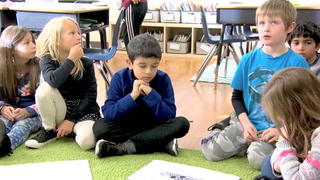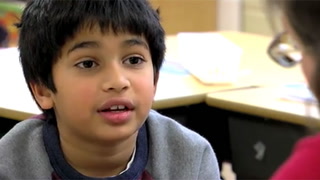Agree/Disagree T-Charts Transcript
Card:
Tch
TeachingChannel
+++ 00:00:03 +++
Kitten Vaa: You’re going to tell me whether you agree or disagree on the idea that the water went through the ground to the town. “I know this because..” And you’re going to me what evidence do you have to support that idea.
+++ 00:00:17 +++
Jessica Thompson: When you’re making an evidence-based argument, you are rallying evidence from multiple sources. And this is an important skill for students to have not just in science, but in social studies, in literacy, in mathematics.
Card:
Agree/Disagree T-Charts:
Supporting claims with multiple sources of evidence
+++ 00:00:36 +++
Kitten Vaa: So, we’ve been investigating the town of Moncton and we’ve been wondering and investigating the question “What caused the town to flood?”
Lower third:
Jessica Thompson
Professor of Science Education
University of Washington, Seattle WA
+++ 00:00:46 +++
Jessica Thompson: In this video, you’ll see students weighing ideas and evaluating evidence. They’re going to be looking at multiple forms of evidence across an entire unit.
+++ 00:00:57 +++
Kitten Vaa: In our investigations, we now know that this mountain is made out of--
Class: Rocks and stones.
Kitten Vaa: Pebbles--
Class: Glacial moraine.
Kitten Vaa: --sand-- yeah-- and soil. Right?
Class: And soil.
Card:
Kitten Vaa
2nd Grade Teacher
Brighton School, Mountlake Terrace WA
+++ 00:01:10 +++
Kitten Vaa: It’s meaningful for students because they have these activities that are connected to a phenomena, using the activities and readings and texts and a variety of different pieces of evidence and even their own personal experiences in the natural world and trying to make sense of that phenomena. Students used different color stickies to show the different types of evidence.
Card:
Sources of evidence
+++ 00:01:33 +++
Kitten Vaa: We started with drawing our initial models and talking about our own ideas and personal experiences about what we think caused the town to flood. And we came up with three ideas. We have three claims.
Card:
Agree/disagree T-charts
+++ 00:01:46 +++
Kitten Vaa: One where it built up behind. We have another one where the water went through the ground. And our third claim was that the water made a new path. And we’ve been using these to help us make some sense while we’re collecting evidence on whether we agree or disagree with these ideas.
+++ 00:02:03 +++
Kitten Vaa: At the beginning, we really focused on students using their own personal experience as a way to support or disprove the claims that were being created.
Lower third:
Teacher Video
+++ 00:02:13 +++
Student: So, me and Andrew were using those tools and we pushed the water off the concrete. And, so, then it soaked inside the soil.
Student: I’m thinking it should go right here.
Kitten Vaa: Can you explain why?
Student: Well, ‘cause if we wanted to agree it would be, “It went in a new path.” It’s not-- ‘cause it says, like, it stays on top of the ground, not basically under the ground. So--
+++ 00:02:38 +++
Kitten Vaa: So, that’s evidence to support that it didn’t go on top of the ground, that it went under the ground.
+++ 00:02:44 +++
Kitten Vaa: And then as students built their knowledge, they started using other pieces of evidence in the experiments that they’ve done, the videos that we were watching, the texts that we were reading.
+++ 00:02:56 +++
Student: That was text evidence.
Kitten Vaa: So, you have some text evidence that said-- can you summarize what it said for me? What does it say that--?
Student: This group of scientists thought that when the dam was being built next to a glacier moraine, that it would cause water to lead through small rocks and sand very easily, but it did really kind of hard and easy. So, we didn’t know where to put this.
+++ 00:03:26 +++
Kitten Vaa: So, they have some text evidence that they’re not sure if it proves or disproves the idea that water went through the ground.
Student: Who think it’s in “Agree”? One, two--
Kitten Vaa: That this proves that idea.
Student: --three, four, five, six, seven, eight, nine, ten.
+++ 00:03:44 +++
Kitten Vaa: Students were able to go to other pieces of evidence to help support this text and what was meant by “easily”. Students were going to the experiment that we had done to talk about the earth materials and whether the water flow was easily-- went through or not. And, so, that was an opportunity for students to add on, to clarify, with those ideas.
+++ 00:04:09 +++
Student: And we put rock, sand and soil all in one cup and we timed that one.
Student: Yes and--
Student: So, that could help you clarify the statement. It didn’t, like, take as long as clay, because clay took a pretty long time. But it still went pretty slow through the glacier moraine.
Student: I agree that I’m pretty sure this one does go in agree.
+++ 00:04:35 +++
Kitten Vaa: As a science community, if we’re building our ideas and our arguments, having sources from a variety of different types of evidence would create a stronger claim.
+++ 00:04:45 +++
Kitten Vaa: So, you’re going to go back to yesterday’s work and be thinking about some of the evidence that you collected. It’s important that you have one color or lots of colors?
Class: Lots of colors.
Kitten Vaa: Lots of colors to support that claim to make it stronger. Okay.
+++ 00:04:57 +++
Jessica Thompson: The sources of evidence could just be kids naming, “This was in a personal experience. This was from an experiment.” But rather than that, we’re diving into the particulars of what did we learn from that personal experience and how does sit up close, how do we juxtapose that to what we saw happen in an experiment? So, it’s in the weighing of and evaluating of ideas.
Card:
Ben
2nd Grade Student
Brighton School, Mountlake Terrace WA
+++ 00:05:18 +++
Ben: Evidence is like ideas from other things that can help support your claim or it might be an experiment that you’ve done and you figured out the answer--
Kitten Vaa: Mm-hm.
Ben: --to the question and to support that claim.
+++ 00:05:36 +++
Kitten Vaa: I want to thank you for sharing and taking a stand today. And we’ll continue thinking more-- yes. And we’ll continue thinking more about what’s causing this.
Card:
Tch
TeachingChannel














3 Comments
Paula Pleasant Dec 26, 2020 10:13am
Paula Pleasant
I like that they used different colors for the different kinds/ sources of evidence. The "T" chart was a great way for the students to think and sort evidence together.
ELIZABETH CLEMENT Aug 17, 2020 8:37pm
I like that they have to have evidence to add to their opinion. This helps with the kids abilities to be able to argue their point in the future and change their views when they see good evidence.
Gloria Mendoza May 5, 2017 12:39am